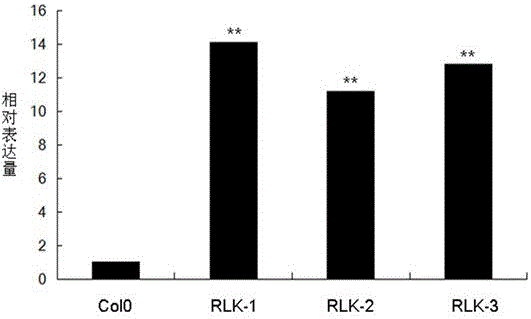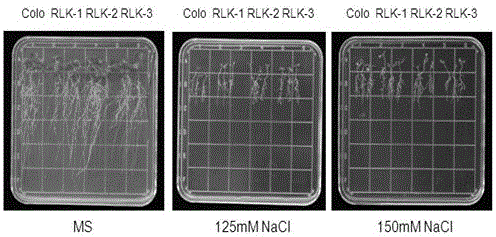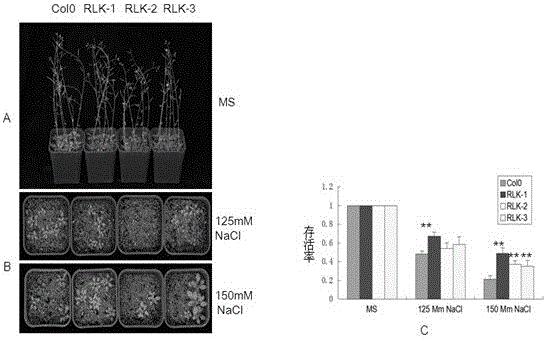LRR-RLK (leucine-rich repeats-receptor-like kinase) in arabidopsis thaliana and application thereof
A technology of protein kinase and Arabidopsis thaliana, applied in the field of genetic engineering, can solve the problems of large investment and low benefit, and achieve the effect of strong stress resistance and low degree of cell damage
- Summary
- Abstract
- Description
- Claims
- Application Information
AI Technical Summary
Problems solved by technology
Method used
Image
Examples
Embodiment 1
[0029] Embodiment one: Arabidopsis LRR-RLK protein kinase protein gene AtRLK clone
[0030] 1. Extraction of total RNA from Arabidopsis thaliana
[0031] All experimental drugs were purchased from Zhongke Ruitai Bioengineering Co., Ltd. The mortars, pipette tips, centrifuge tubes and other items used should be soaked in 1% DEPC water overnight, and then sterilized under high temperature and high pressure for later use.
[0032] (1) RNA extraction reference (TRIZOL TM KitRNA Extraction Reagent Manual)
[0033] (2) Take 50 mg of fresh plant tissue samples and grind them with liquid nitrogen;
[0034] (3) Add 1ml TRIZOL and place at room temperature (20-25°C, the same below) for 10min;
[0035] (4) Add 200 μl of chloroform, shake vigorously for 60 seconds, and place at room temperature for 5 minutes;
[0036] (5) Centrifuge at 12,000 rpm for 10 min (4°C), take 500 μl of supernatant into a new PE tube, add 1 ml of absolute ethanol, mix well, and place at -20°C for 20 min;
[...
Embodiment 2
[0053] Embodiment two: Utilize pCAMBIA1301 vector construction CaMV35S - AtRLK fusion gene
[0054] (1) Extract vector pCAMBIA1301 plasmid (purchased from CAMBIA Company) from Escherichia coli, use Nco I / BstE After II double enzyme digestion, the target vector fragment is recovered.
[0055] (2) to the reclaimed of embodiment 1 AtRIPK The CDS fragment of the gene is used Nco I / BstE II double enzyme digestion, and recover the digested fragments (same as in Example 1) by agarose gel electrophoresis.
[0056] (3) The above two fragments were ligated overnight at 16°C under the catalysis of ligase to complete the pCAMBIA1301 carrier CaMV35S - AtRLK Fusion gene construction.
[0057] Connection system:
[0058] AtRLK Gene CDS fragment (50ng / μl): 2μl;
[0059] pCAMBIA1301 vector (50ng / μl): 3μl;
[0060] SolutionI ligase 5 μl;
[0061] (4) Transform Escherichia coli DH5α competent cells with the ligation mixture, the specific method is as follows:
[0062] Pre...
Embodiment 3
[0071] Example 3: Preparation of transgenic Arabidopsis plants
[0072] (1) constructed with embodiment two CaMV35S - AtRLK The fusion gene was transformed into Arabidopsis thaliana, and the obtained seeds were subjected to 50mgl -1 For hygromycin resistance screening, normal growing plants were transferred to nutrient soil for culture.
[0073] (2) Real-time quantitative RT-PCR detection of transgenic plants: the transgenic Arabidopsis thaliana material identified by PCR in Example 2 is multiplied, after 50mgl -1 Hygromycin resistance screened for T 3 Homozygous transgenic lines were generated, wild-type and transgenic Arabidopsis seedlings grown for one week were respectively obtained, and total RNA from plant tissues was extracted according to the method in Example 1 and reverse-transcribed into mRNA. SYBRGreenRealtimePCRMasterMixplus (TOYUBO, QPK-212) kit was used for qRT-PCR detection, and the operation was completed according to the kit instructions.
[0074] Detec...
PUM
 Login to View More
Login to View More Abstract
Description
Claims
Application Information
 Login to View More
Login to View More - R&D
- Intellectual Property
- Life Sciences
- Materials
- Tech Scout
- Unparalleled Data Quality
- Higher Quality Content
- 60% Fewer Hallucinations
Browse by: Latest US Patents, China's latest patents, Technical Efficacy Thesaurus, Application Domain, Technology Topic, Popular Technical Reports.
© 2025 PatSnap. All rights reserved.Legal|Privacy policy|Modern Slavery Act Transparency Statement|Sitemap|About US| Contact US: help@patsnap.com



